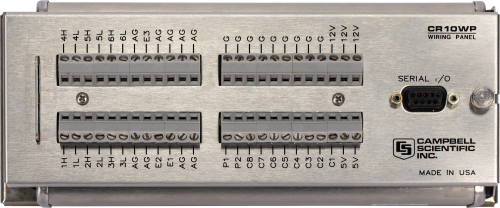This product is not available for new orders. We recommend ordering: CR1000.

| Services Available | |
|---|---|
| Repair | No |
| Calibration | Yes |
| Free Support | No |
概览
The CR10 was a predecessor of the CR10X. The CR10X was eventually replaced with the CR1000. The CR10 consisted of a CR10M Measurement and Control Module and a CR10WP Wiring Panel.
优势与特点
- 1987-1996年间生产
- 基于数组的数据格式
- 维修仍然有效
图像

技术说明
The CR10 had 12 single-ended (six differential) analog input channels, three switched excitation outputs, eight input/output control ports, two pulse counting channels, and a serial I/O port. It provided sensor measurement, timekeeping, data reduction, data/program storage and control functions. Up to 29,908 data points were stored in it's internal memory.
CR10s manufactured after 1 December 1993 (SN>19273) contained an internal jumper that supported use of 2 or 4 kbytes program memory (appropriate PROM also required).
产品规格
| -NOTE- | Note: Additional specifications are listed in the CR10 Specifications Sheet. |
| Analog Input Channels | 12 single-ended (six differential) |
| Switched Excitation Outputs | 3 |
| Input/Output Control Ports | 8 |
| Pulse Count Channels | 2 |
| Serial I/O Port | 1 |
| Memory | Stores up to 29,908 data points in internal memory. |
兼容性
A typical field-based CR10 system consisted of:
- CR10 with OS10 Operating System
- Alkaline or Rechargeable Power Supply
- Weatherproof Enclosure (CR10s ordered with an environmental enclosure were mounted on the enclosure backplate at the factory)
CR10 peripherals such as the CR10KD and CR10TCR, as well as sensors and data retrieval peripherals, were added to complete the system.
常见问题解答
CR10: 2
-
The CPU of the data logger can be removed and mated with a different CR800 wiring panel. This can be done by removing the four corner nuts on the underside of the CR800. Do not loosen the two middle nuts. Be careful not to damage the pins mating the CPU with the wiring panel.
-
A practical maximum is to connect one multiplexer per every two control terminals on the data logger. Control terminals can be shared between multiplexers to increase the number of connected multiplexers. Sharing terminals, however, requires more complex wiring and programming. Users who would like to connect more than one multiplexer per every two control terminals are advised to contact a sales or support engineer at Campbell Scientific for assistance.
案例研究
In an era when water is becoming a precious resource, the Emery Water Conservancy District......阅读更多
More than 50 CR10-based monitoring systems were used for structural monitoring during the construction of......阅读更多
Dunhuang (population 100,000) is on the southwestern edge of the Gobi Desert and is situated......阅读更多
The Poulsbo Marine Science Center is a non-profit educational facility located on Liberty Bay on......阅读更多
Following an inspection a decade ago, the Welsh Office was advised to reduce the allowable......阅读更多
In a country as large as Argentina, monitoring growing conditions in different agricultural regions is......阅读更多
To overcome the difficulties associated with monitoring the hydrophysical properties of water in deep wells,......阅读更多
Jordan Commons in southern Dade County is an innovative, energyefficient housing development being constructed for......阅读更多




